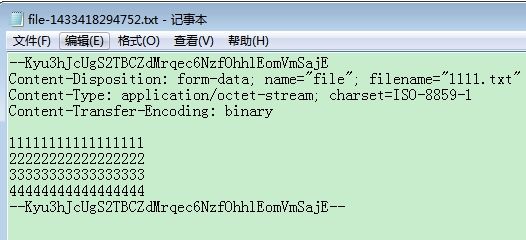大文件传输的三种方式
前言:因自己负责的项目(jetty内嵌启动的SpringMvc)中需要实现文件上传,而自己对java文件上传这一块未接触过,且对 Http 协议较模糊,故这次采用渐进的方式来学习文件上传的原理与实践。该博客重在实践。
一. Http协议原理简介
HTTP是一个属于应用层的面向对象的协议,由于其简捷、快速的方式,适用于分布式超媒体信息系统。它于1990年提出,经过几年的使用与发展,得到不断地完善和扩展。目前在WWW中使用的是HTTP/1.0的第六版,HTTP/1.1的规范化工作正在进行之中,而且HTTP-NG(Next Generation of HTTP)的建议已经提出。
简单来说,就是一个基于应用层的通信规范:双方要进行通信,大家都要遵守一个规范,这个规范就是HTTP协议。
1.特点:
(1)支持客户/服务器模式。
(2)简单快速:客户向服务器请求服务时,只需传送请求方法和路径。请求方法常用的有GET、HEAD、POST。每种方法规定了客户与服务器联系的类型不同。由于HTTP协议简单,使得HTTP服务器的程序规模小,因而通信速度很快。
(3)灵活:HTTP允许传输任意类型的数据对象。正在传输的类型由Content-Type加以标记。
(4)无连接:无连接的含义是限制每次连接只处理一个请求。服务器处理完客户的请求,并收到客户的应答后,即断开连接。采用这种方式可以节省传输时间。
(5)无状态:HTTP协议是无状态协议。无状态是指协议对于事务处理没有记忆能力。缺少状态意味着如果后续处理需要前面的信息,则它必须重传,这样可能导致每次连接传送的数据量增大。另一方面,在服务器不需要先前信息时它的应答就较快。
注意:其中(4)(5)是面试中常用的面试题。虽然HTTP协议(应用层)是无连接,无状态的,但其所依赖的TCP协议(传输层)却是常连接、有状态的,而TCP协议(传输层)又依赖于IP协议(网络层)。
2.HTTP消息的结构
(1)Request 消息分为3部分,第一部分叫请求行, 第二部分叫http header消息头, 第三部分是body正文,header和body之间有个空行, 结构如下图
(2)Response消息的结构, 和Request消息的结构基本一样。 同样也分为三部分,第一部分叫request line状态行, 第二部分叫request header消息体,第三部分是body正文, header和body之间也有个空行, 结构如下图
下面是使用Fiddler捕捉请求baidu的Request消息机构和Response消息机构:
因为没有输入任何表单信息,故request的消息正文为空,大家可以找一个登录的页面试试看。
先到这里,HTTP协议的知识网上很丰富,在这里就不再熬述了。
二. 文件上传的三种实现
1. Jsp/servlet 实现文件上传
这是最常见也是最简单的方式
(1)实现文件上传的Jsp页面
(2)负责接文件的FileUploadServlet
import java.io.File;
import java.io.FileOutputStream;
import java.io.IOException;
import java.io.InputStream;
import javax.servlet.ServletException;
import javax.servlet.http.HttpServlet;
import javax.servlet.http.HttpServletRequest;
import javax.servlet.http.HttpServletResponse;
import org.apache.log4j.Logger;
// @WebServlet(name = "FileLoadServlet", urlPatterns = {"/fileload"})
publicclass FileLoadServlet extends HttpServlet {
privatestatic Logger logger = Logger.getLogger(FileLoadServlet.class);
privatestaticfinallong serialVersionUID = 1302377908285976972L;
@Override
protectedvoid service(HttpServletRequest request, HttpServletResponse response)throws ServletException, IOException {
logger.info("------------ FileLoadServlet ------------");
if(request.getContentLength()> 0){
InputStream inputStream =null;
FileOutputStream outputStream =null;
try{
inputStream = request.getInputStream();
// 给新文件拼上时间毫秒,防止重名
long now = System.currentTimeMillis();
File file =new File("c:/","file-"+ now +".txt");
file.createNewFile();
outputStream =new FileOutputStream(file);
byte temp[]=newbyte[1024];
int size =-1;
while((size = inputStream.read(temp))!=-1){// 每次读取1KB,直至读完
outputStream.write(temp, 0, size);
}
logger.info("File load success.");
}catch(IOException e){
logger.warn("File load fail.", e);
request.getRequestDispatcher("/fail.jsp").forward(request, response);
}finally{
outputStream.close();
inputStream.close();
}
}
request.getRequestDispatcher("/succ.jsp").forward(request, response);
}
}
FileUploadServlet的配置,推荐采用servlet3.0注解的方式更方便
(3)运行效果
点击"submit"
页面转向文件上传成功的页面,再去C盘看看,发现多了一个文件:file-1433417127748.txt,这个就是刚上传的文件
我们打开看看,发现和原来的文本有些不一样
结合前面讲的HTTP协议的消息结构,不难发现这些文本就是去掉"请求头"后的"Request消息体"。所以,如果要得到与上传文件一致的文本,还需要一些字符串操作,这些就留给大家了。
另外,大家可以试试一个Jsp页面上传多个文件,会有不一样的精彩哦o(∩_∩)o ,不解释。
2. 模拟Post请求/servlet 实现文件上传
刚才我们是使用Jsp页面来上传文件,假如客户端不是webapp项目呢,显然刚才的那种方式有些捉襟见衬了。
这里我们换种思路,既然页面上通过点击可以实现文件上传,为何不能通过HttpClient来模拟浏览器发送上传文件的请求呢。关于HttpClient ,大家可以自己去了解。
(1)还是这个项目,启动servlet服务
(2)模拟请求的FileLoadClient
import java.io.BufferedReader;
import java.io.File;
import java.io.InputStream;
import java.io.InputStreamReader;
import org.apache.commons.httpclient.HttpClient;
import org.apache.commons.httpclient.HttpStatus;
import org.apache.commons.httpclient.methods.PostMethod;
import org.apache.commons.httpclient.methods.multipart.FilePart;
import org.apache.commons.httpclient.methods.multipart.MultipartRequestEntity;
import org.apache.commons.httpclient.methods.multipart.Part;
import org.apache.log4j.Logger;
publicclass FileLoadClient {
privatestatic Logger logger = Logger.getLogger(FileLoadClient.class);
publicstatic String fileload(String url, File file){
String body ="{}";
if(url ==null|| url.equals("")){
return"参数不合法";
}
if(!file.exists()){
return"要上传的文件名不存在";
}
PostMethod postMethod =new PostMethod(url);
try{
// FilePart:用来上传文件的类,file即要上传的文件
FilePart fp =new FilePart("file", file);
Part[] parts ={ fp };
// 对于MIME类型的请求,httpclient建议全用MulitPartRequestEntity进行包装
MultipartRequestEntity mre =new MultipartRequestEntity(parts, postMethod.getParams());
postMethod.setRequestEntity(mre);
HttpClient client =new HttpClient();
// 由于要上传的文件可能比较大 , 因此在此设置最大的连接超时时间
client.getHttpConnectionManager().getParams().setConnectionTimeout(50000);
int status = client.executeMethod(postMethod);
if(status == HttpStatus.SC_OK){
InputStream inputStream = postMethod.getResponseBodyAsStream();
BufferedReader br =new BufferedReader(new InputStreamReader(inputStream));
StringBuffer stringBuffer =new StringBuffer();
String str ="";
while((str = br.readLine())!=null){
stringBuffer.append(str);
}
body = stringBuffer.toString();
}else{
body ="fail";
}
}catch(Exception e){
logger.warn("上传文件异常", e);
}finally{
// 释放连接
postMethod.releaseConnection();
}
return body;
}
publicstaticvoid main(String[] args)throws Exception {
String body = fileload("http://localhost:8080/jsp_upload-servlet/fileload",new File("C:/1111.txt"));
System.out.println(body);
}
}
(3)在Eclipse中运行FileLoadClient程序来发送请求,运行结果:
File upload success
return打印了:文件上传成功的succ.jsp页面
有没有发现什么,是不是和前面Jsp页面上传的结果类似?对的,还是去掉"请求头"后的"Request消息体"。
这种方式也很简单,负责接收文件的FileUploadServlet没有变,只要在客户端把文件读取到流中,然后模拟请求servlet就行了。
3.模拟Post请求/Controller(SpringMvc)实现文件上传
终于到第三种方式了,主要难点在于搭建maven+jetty+springmvc环境,接收文件的service和模拟请求的客户端 和上面相似。
(1)模拟请求的FileLoadClient未变
import java.io.BufferedReader;
import java.io.File;
import java.io.InputStream;
import java.io.InputStreamReader;
import org.apache.commons.httpclient.HttpClient;
import org.apache.commons.httpclient.HttpStatus;
import org.apache.commons.httpclient.methods.PostMethod;
import org.apache.commons.httpclient.methods.multipart.FilePart;
import org.apache.commons.httpclient.methods.multipart.MultipartRequestEntity;
import org.apache.commons.httpclient.methods.multipart.Part;
import org.apache.log4j.Logger;
publicclass FileLoadClient {
privatestatic Logger logger = Logger.getLogger(FileLoadClient.class);
publicstatic String fileload(String url, File file){
String body ="{}";
if(url ==null|| url.equals("")){
return"参数不合法";
}
if(!file.exists()){
return"要上传的文件名不存在";
}
PostMethod postMethod =new PostMethod(url);
try{
// FilePart:用来上传文件的类,file即要上传的文件
FilePart fp =new FilePart("file", file);
Part[] parts ={ fp };
// 对于MIME类型的请求,httpclient建议全用MulitPartRequestEntity进行包装
MultipartRequestEntity mre =new MultipartRequestEntity(parts, postMethod.getParams());
postMethod.setRequestEntity(mre);
HttpClient client =new HttpClient();
// 由于要上传的文件可能比较大 , 因此在此设置最大的连接超时时间
client.getHttpConnectionManager().getParams().setConnectionTimeout(50000);
int status = client.executeMethod(postMethod);
if(status == HttpStatus.SC_OK){
InputStream inputStream = postMethod.getResponseBodyAsStream();
BufferedReader br =new BufferedReader(new InputStreamReader(inputStream));
StringBuffer stringBuffer =new StringBuffer();
String str ="";
while((str = br.readLine())!=null){
stringBuffer.append(str);
}
body = stringBuffer.toString();
}else{
body ="fail";
}
}catch(Exception e){
logger.warn("上传文件异常", e);
}finally{
// 释放连接
postMethod.releaseConnection();
}
return body;
}
publicstaticvoid main(String[] args)throws Exception {
String body = fileload("http://localhost:8080/fileupload/upload",new File("C:/1111.txt"));
System.out.println(body);
}
}
(2)servlet换为springMvc中的Controller
import java.io.File;
import java.io.FileOutputStream;
import java.io.IOException;
import java.io.InputStream;
import javax.servlet.http.HttpServletRequest;
import javax.servlet.http.HttpServletResponse;
import org.apache.log4j.Logger;
import org.springframework.stereotype.Controller;
import org.springframework.web.bind.annotation.RequestMapping;
import org.springframework.web.bind.annotation.RequestMethod;
@Controller
@RequestMapping("/fileupload")
publicclass FileUploadService {
private Logger logger = Logger.getLogger(FileUploadService.class);
@RequestMapping(consumes ="multipart/form-data", value ="/hello", method = RequestMethod.GET)
publicvoid hello(HttpServletRequest request, HttpServletResponse response)throws IOException {
response.getWriter().write("Hello, jetty server start ok.");
}
@RequestMapping(consumes ="multipart/form-data", value ="/upload", method = RequestMethod.POST)
publicvoid uploadFile(HttpServletRequest request, HttpServletResponse response)throws IOException {
String result ="";
if(request.getContentLength()> 0){
InputStream inputStream =null;
FileOutputStream outputStream =null;
try{
inputStream = request.getInputStream();
// 给新文件拼上时间毫秒,防止重名
long now = System.currentTimeMillis();
File file =new File("c:/","file-"+ now +".txt");
file.createNewFile();
outputStream =new FileOutputStream(file);
byte temp[]=newbyte[1024];
int size =-1;
while((size = inputStream.read(temp))!=-1){// 每次读取1KB,直至读完
outputStream.write(temp, 0, size);
}
logger.info("File load success.");
result ="File load success.";
}catch(IOException e){
logger.warn("File load fail.", e);
result ="File load fail.";
}finally{
outputStream.close();
inputStream.close();
}
}
response.getWriter().write(result);
}
}
(3)启动jetty的核心代码,在Eclipse里面右键可以启动,也可以把项目打成jar报启动
import org.apache.log4j.Logger;
import org.eclipse.jetty.server.Connector;
import org.eclipse.jetty.server.Server;
import org.eclipse.jetty.server.ServerConnector;
import org.eclipse.jetty.webapp.WebAppContext;
publicclass Launcher
{
privatestatic Logger logger = Logger.getLogger(Launcher.class);
privatestaticfinalint PORT = 8080;
privatestaticfinal String WEBAPP ="src/main/webapp";
privatestaticfinal String CONTEXTPATH ="/";
privatestaticfinal String DESCRIPTOR ="src/main/webapp/WEB-INF/web.xml";
/*
* 创建 Jetty Server,指定其端口、web目录、根目录、web路径
* @param port
* @param webApp
* @param contextPath
* @param descriptor
* @return Server
*/
publicstatic Server createServer(int port, String webApp, String contextPath, String descriptor){
Server server =new Server();
//设置在JVM退出时关闭Jetty的钩子
//这样就可以在整个功能测试时启动一次Jetty,然后让它在JVM退出时自动关闭
server.setStopAtShutdown(true);
ServerConnector connector =new ServerConnector(server);
connector.setPort(port);
//解决Windows下重复启动Jetty不报告端口冲突的问题
//在Windows下有个Windows + Sun的connector实现的问题,reuseAddress=true时重复启动同一个端口的Jetty不会报错
//所以必须设为false,代价是若上次退出不干净(比如有TIME_WAIT),会导致新的Jetty不能启动,但权衡之下还是应该设为False
connector.setReuseAddress(false);
server.setConnectors(new Connector[]{connector});
WebAppContext webContext =new WebAppContext(webApp, contextPath);
webContext.setDescriptor(descriptor);
// 设置webapp的位置
webContext.setResourceBase(webApp);
webContext.setClassLoader(Thread.currentThread().getContextClassLoader());
server.setHandler(webContext);
return server;
}
/**
* 启动jetty服务
*/
publicvoid startJetty(){
final Server server = Launcher.createServer(PORT, WEBAPP, CONTEXTPATH, DESCRIPTOR);
try{
server.start();
server.join();
}catch(Exception e){
logger.warn("启动 jetty server 失败", e);
System.exit(-1);
}
}
publicstaticvoid main(String[] args){
(new Launcher()).startJetty();
// jetty 启动后的测试url
// http://localhost:8080/fileupload/hello
}
}
springMvc的配置不贴了,大家可以下载源码下来看。
(4)运行效果
上传包含1W个文件的文件夹,正常
大型文件续传功能正常 。
![]()
文件批量上传正常
![]()
服务器中已经根据日期+GUID生成了目录
数据库中也有记录
后端代码逻辑大部分是相同的,目前能够支持MySQL,Oracle,SQL。在使用前需要配置一下数据库,可以参考我写的这篇文章:http://blog.ncmem.com/wordpress/2019/08/12/java-http%E5%A4%A7%E6%96%87%E4%BB%B6%E6%96%AD%E7%82%B9%E7%BB%AD%E4%BC%A0%E4%B8%8A%E4%BC%A0/













